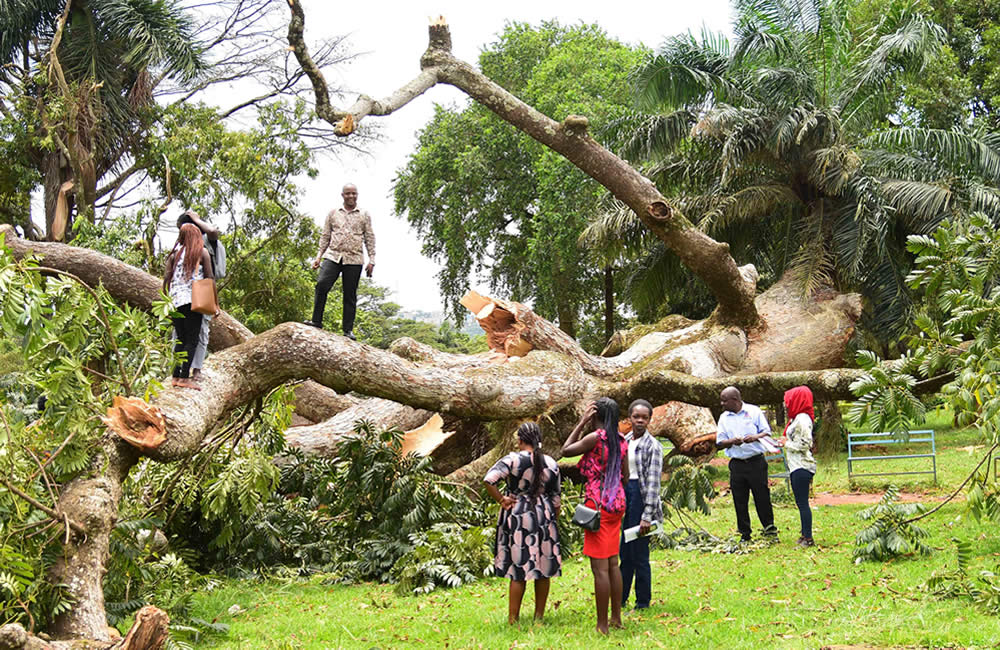The recent torrential rainfall at Kyambogo University not only drenched the campus but also brought down a venerable symbol of Uganda’s educational heritage: a majestic Canarium tree, affectionately known as Muwafu in central Uganda. This tree, steeped in over 150 years of history, held a profound significance as the site where pivotal moments in Uganda’s educational and cultural evolution unfolded.
Legend has it that beneath the sprawling branches of this ancient Muwafu tree, the 30th King of Buganda, Walugembe Muteesa I, once convened with the renowned American explorer Henry Morton Stanley. It was here that a historic letter was penned, extending an invitation to Anglican missionaries, a missive that would ultimately shape the trajectory of formal education in Uganda.
The fall of this historic tree not only marked the loss of a tangible link to the past but also stirred reflections on the importance of preserving cultural heritage and fostering critical thinking. For archaeologists at Kyambogo University, the felling of the Muwafu tree served as a poignant reminder of the fragile yet enduring connections between the past and the present.
In 1877, inspired by Muteesa’s letter, the first cohort of Christian missionaries embarked on a journey to the Buganda Kingdom under the auspices of the Church Missionary Society (CMS). Their arrival heralded a new era of educational enlightenment, as they introduced both Christian teachings and formal schooling to the region.
The significance of the Muwafu tree extended beyond its role in facilitating historical meetings and correspondence. Situated within the grounds of the Banda Palace, the tree bore witness to pivotal moments in Uganda’s history, including the famed encounter between Muteesa I and European explorers John Speke and James Grant in 1862.
Recognizing the profound cultural and educational legacy embodied by the Muwafu tree, stakeholders at Kyambogo University rallied to preserve its memory. Plans to construct a Teacher Technical Education Building were reconsidered, with calls for the site to be commemorated as a symbol of Uganda’s educational roots.
Prof. Elizabeth Kyazike, an archeologist at Kyambogo University, underscored the tree’s significance, emphasizing its role as a beacon of educational heritage. “We are proud of this tree because it is the beginning of our formal education,” she remarked, advocating for the preservation of its legacy.
Dr. Stephen Kasumba, who bore witness to the tree’s collapse, echoed these sentiments, calling for the establishment of a museum to honor its memory and safeguard its historical significance. His plea was echoed by Mr. Moses Jjuuko, President of the Kyambogo University History, Archaeology, and Heritage Students Association, who emphasized the tree’s broader cultural importance.
As efforts to preserve the memory of the Muwafu tree gain momentum, the university administration has pledged to replant a new sapling in its place. Additionally, plans are underway to study the fallen tree’s remains and collaborate with the Buganda Kingdom to ensure that its legacy endures.
In reflecting on the loss of this venerable symbol, Buganda Kingdom Prime Minister Charles Peter Mayiga remarked, “That is the tree under which Kabaka Muteesa I sat when he was writing the letter to Queen Victoria in 1875.” His words serve as a poignant reminder of the enduring legacy of the Muwafu tree and its pivotal role in shaping Uganda’s cultural and educational landscape.




















